Bee Smoker Fuel
One of the most useful tools in beekeeping, a properly used smoker actually saves bee lives. But, it is important to chose the right fuel for your bee smoker. Beekeepers have several good options for combustible material. But, your choice may depend in part on what is readily available to you. To avoid doing harm to the bees and yourself, you need to know what you can use as bee smoker fuel and and what should you avoid.
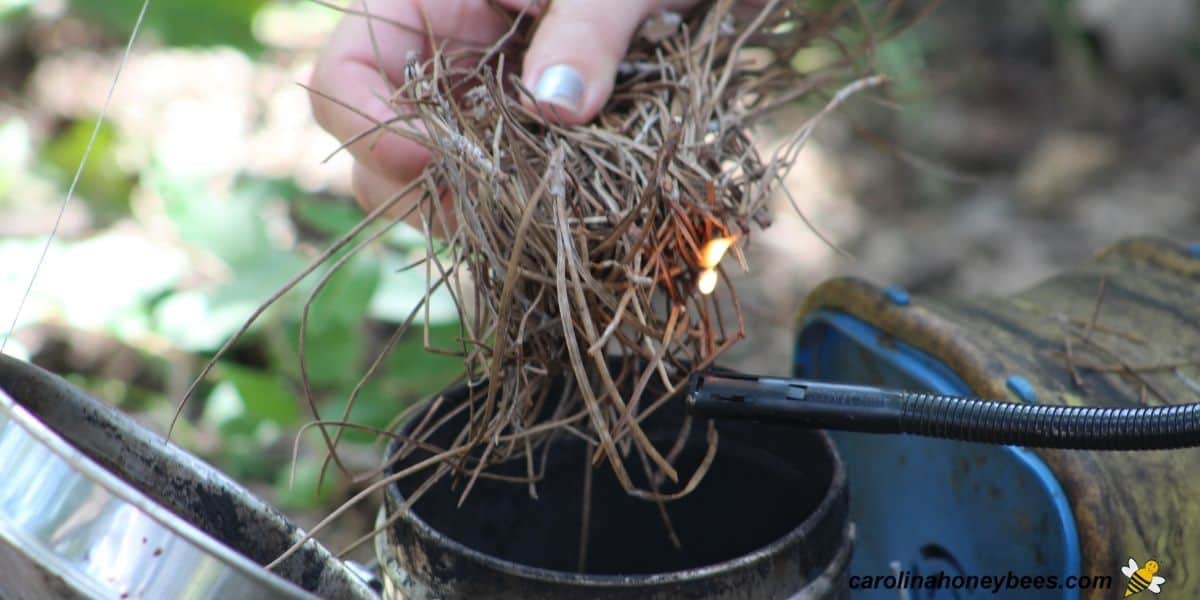
This tutorial serves as a guide for beekeepers who are seeking safe materials to use in their smokers. An essential part of any beekeeper’s equipment and supplies – we will look at traditional options, as well as, some modern alternatives.
Types of Bee Smoker Fuel
A bee smoker relies on fuel to produce the cool, white smoke that beekeepers use during hive inspections. While there are numerous options, they can be generally classified into two categories.
- traditional – commonly used for many years
- modern – designed for convenience and consistency
This post may contain affiliate links. As an Amazon Associate, I earn from qualifying purchases. Please read my disclosure.
Traditional
Traditional bee smoker fuels are those that were readily available to beekeepers of the day-and still are. Most were natural materials readily available from nature or common industry.
- burlap, cotton – lint
- dry pine needles – my fav
- wood shavings – plant material
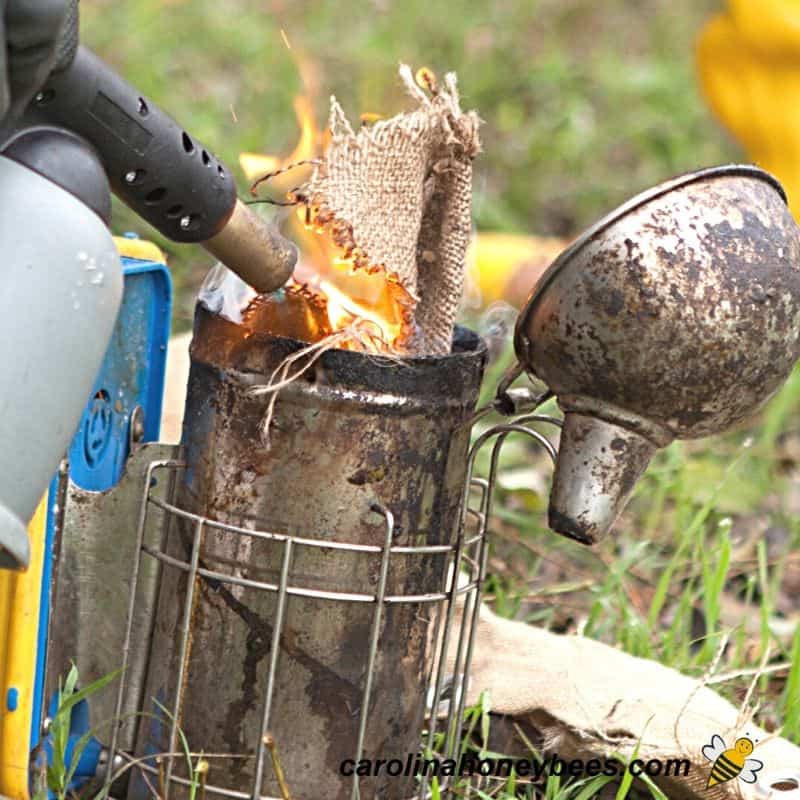
Burlap, Cotton and Lint
Look inside the workshop of many an old-school beekeeper and you will likely find some strips of burlap. Untreated burlap was often valued as a great smoker fuel that would produce a good smoldering blaze. Today, most burlap is treated with chemicals and not the best option.
Cotton is an old standby for use as hive smoker fuel. You will find it in many forms. Some are sections of cotton cloth that can be inserted into the smoker. Still available commercially, they are often purchased in small rolls.
Another option is to use a bag of cotton fiber or stuffings that bee suppliers sell. I find that this smolders quite well and I often keep a bag on hand. It makes a good material to put on top of my pine needles after I get the fire started.
Check the source when you buy this – we want US grown cotton that has not been treated with any nasty chemicals.
Old school beekeepers in my area often used twine – as in baling twine used on hay. But, today finding any twine that is not impregnated with preservative or chemicals is almost impossible.
Dry Pine Needles
Living in the south, I can not write an article about beekeeper smoker fuel without mentioning pine needles.
Because we are gifted with thousands of pine trees – I can gather dry pine needles in the forest. If you are not that lucky, you can buy pine needles too.
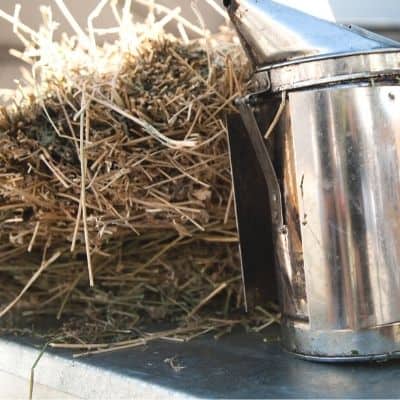
Pine needles are easy to start and produce a beautiful white smoke. This type of smoke produces a calming effect in honey bees and does no harm to the colony.
It is important to keep some fuel (even more pine needles) on top of the burning needles in the bottom. Otherwise, you will have hot smoke. It is the smoldering fuel on top that produces the best smoke.
Using any material with resins, like pine needles, does gum up your smoker over time – a good practice is to clean your bee hive smoker each Spring.
With pine needles, you do have to remember to gather them during dry weather. However, they are light weight and very easy to store in a 5 gallon bucket. Throw in a few dry pine cones too – they work well in your bee smoker.
Wood Shavings – Dried Plant Material
Wood shavings, dried leaves, dried corn cobs or peanut shells can be a part of your smoker fuel lineup. These organic material do burn rather fast. I find them better to use as a starter-than the main fuel source.
Some beekeepers add dried herbs to their beehive smoker. Dried basil, lavender and even citrus peels are found in some smoker fuel recipes.
I approach anything with scent very cautiously. Honey bees are so sensitive to smells that I feel it is best to proceed carefully when using additives.
Modern Options
As with most things in life, we are always busy trying to “improve” things. And sometimes, it works. Today’s beekeepers have a few more modern options when choosing bee smoker fuel. And honestly, most of us use a mixture of traditional and modern fuels.
- wood pellets
- cardboard
Wood Pellets
Some beekeepers in my area enjoy using wood pellets. If you go this route, I would suggest plain hardwood pellets.
Avoid special smoking pellets that provide special “flavors” for seasoning meat. Honey bees are very sensitive to smell.
The advantage of smoker fuel pellets is that they produce a clean smoke and once started will burn for a long period.
However, wood pellets can be difficult to get started burning. You might begin with small pieces of cardboard or another starter and then add your pellets.
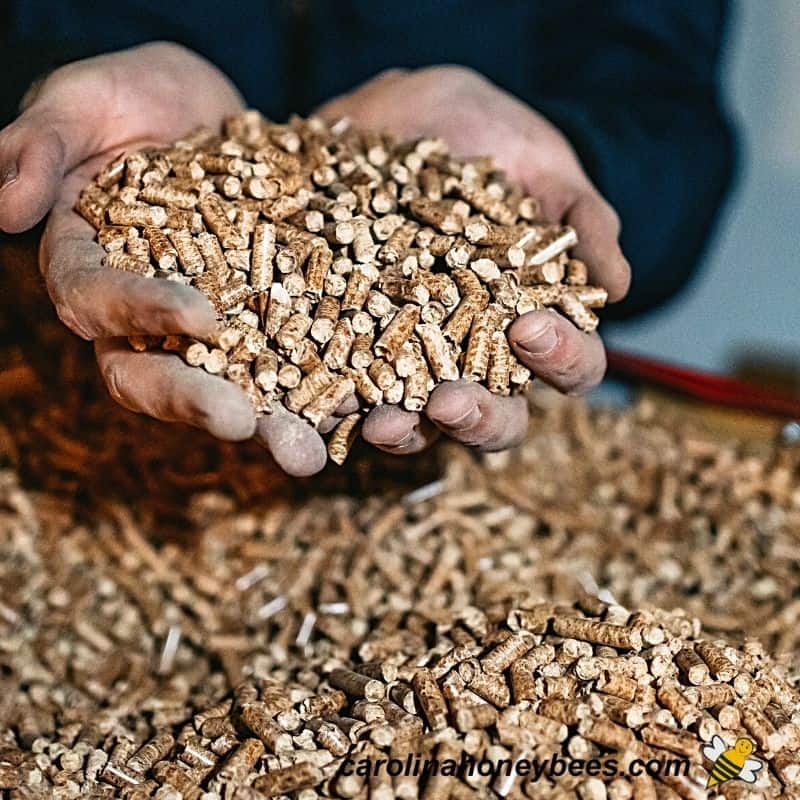
It does not take a lot of pellets to fire the smoker. But, sometimes pellets alone produce hot smoke unless you top the fire with other materials.
Pellet smoker fuel does not have to be purchased from a bee supply but this type of smoker pellets works quite well
Cardboard Rolls or Egg Cartons
We beekeepers are an inventive bunch. Some folks use cardboard rolls (or bundles) as smoker fuel. It can be used as a starter and then cotton, pine needles or other fuels added on top to maintain the flame.
Another way to use cardboard for fuel in the smoker is to create loose rolls that fit down in the smoker chamber.
These are relatively easy to start and when topped with more fuel (cotton, pine needles, etc) produce a nice long lasting smoke. Alone, cardboard tends to burn quickly and make a hot fire.
I often use pieces of paper egg trays as the first fire starter. Then I add other materials once the fire is well started. Those egg cartons also make wonderful homemade beeswax fire starters!!
Properties of Ideal Beehive Smoker Fuel
Now that you can see there are several choices, what do you consider when making a choice? The ideal smoker fuel for you has these characteristics:
- Easy availability
- Produces a cool white smoke
- Stays lit for a while
- Is non toxic to bees and beekeeper
Choosing material that is easy to obtain is important. You don’t want to have to wait weeks for an order to arrive or spend a fortune. There are enough beekeeping costs already!
Cool, white smoke is the goal. Do not use material that creates hot black smoke – the bees will be angry. The whole idea behind a smoker is to calm the colony not rev them up.
We want the fire to smolder more than really burn. Yet, it must retain enough fire coals to produce smoke when needed.
Safety is an important issue – avoid burning anything that may give off toxic fumes. You may harm your colony or yourself.
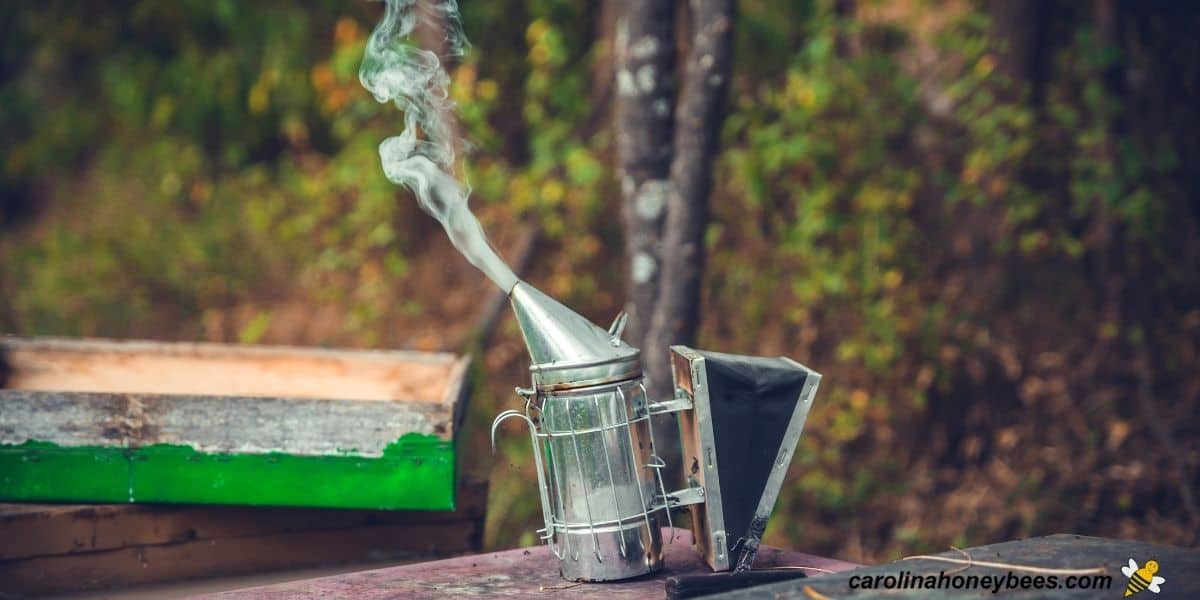
Fuels to Avoid
Not every combustible material is suitable for burning in your bee smoker. Do not use any petroleum products such as kerosene, gasoline, lighter fluid etc. No, not even to get it started.
The smoke produced will be hot and black which is irritating to the bees in the colony and the beekeeper using the smoker.
Avoid denim blue jean material that is loaded with chemical and dyes. Much of the burlap for sale today has been treated with chemicals or dye. If you use burlap as smoker fuel -get untreated burlap.
FAQs
There are several advantages to using traditional bee smoker fuels: easier to obtain, cost-effective and not likely contaminated by chemicals or dyes.
Yes, in addition to only using clean burning materials-seek out locally sourced wood from your own region.
To ensure optimal performance from your smoker fuel, keep it dry and protected in a closed container or bucket. Here it will be protected from moisture and pests.
Final Thoughts
While you have some options, you really need to care about what you burn in your smoker. In fact, only a small amount of smoke is needed. Forget the idea of laying down enough smoke to hide an invading army. That is not necessary.
The fact is that proper use of this important beekeeping tool makes hive inspections much easier. Mastering the technique of lighting a bee smoker takes a bit of practice for the new beekeeper. Choosing the right smoker fuel makes the job easier.

